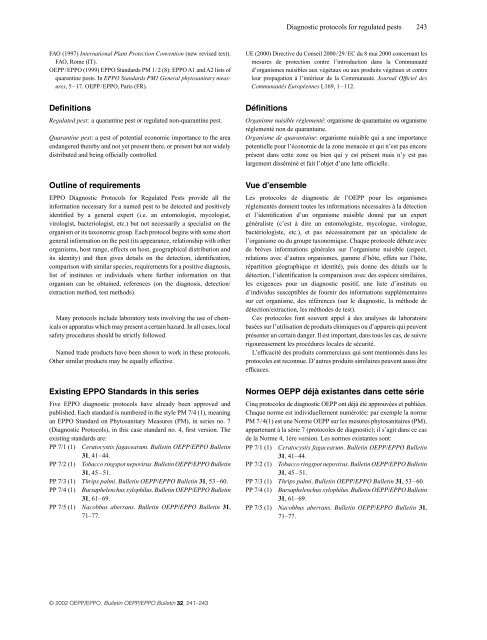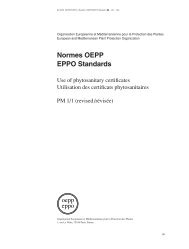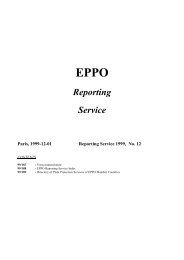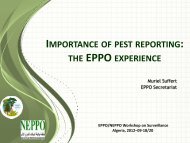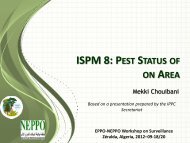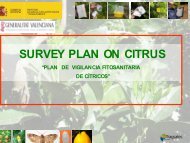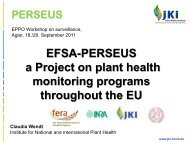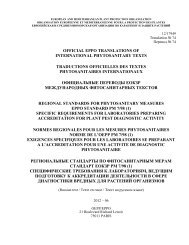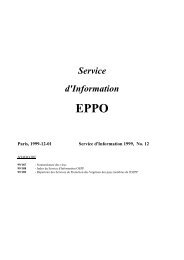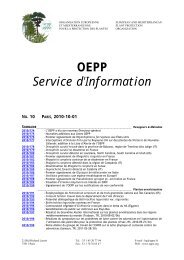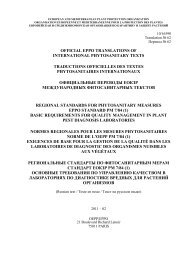Normes OEPP EPPO Standards - Lists of EPPO Standards ...
Normes OEPP EPPO Standards - Lists of EPPO Standards ...
Normes OEPP EPPO Standards - Lists of EPPO Standards ...
You also want an ePaper? Increase the reach of your titles
YUMPU automatically turns print PDFs into web optimized ePapers that Google loves.
FAO (1997) International Plant Protection Convention (new revised text).<br />
FAO, Rome (IT).<br />
<strong>OEPP</strong>/<strong>EPPO</strong> (1999) <strong>EPPO</strong> <strong>Standards</strong> PM 1/2 (8): <strong>EPPO</strong> A1 and A2 lists <strong>of</strong><br />
quarantine pests. In <strong>EPPO</strong> <strong>Standards</strong> PM1 General phytosanitary measures,<br />
5–17. <strong>OEPP</strong>/<strong>EPPO</strong>, Paris (FR).<br />
Definitions<br />
Regulated pest: a quarantine pest or regulated non-quarantine pest.<br />
Quarantine pest: a pest <strong>of</strong> potential economic importance to the area<br />
endangered thereby and not yet present there, or present but not widely<br />
distributed and being <strong>of</strong>ficially controlled.<br />
Outline <strong>of</strong> requirements<br />
<strong>EPPO</strong> Diagnostic Protocols for Regulated Pests provide all the<br />
information necessary for a named pest to be detected and positively<br />
identified by a general expert (i.e. an entomologist, mycologist,<br />
virologist, bacteriologist, etc.) but not necessarily a specialist on the<br />
organism or its taxonomic group. Each protocol begins with some short<br />
general information on the pest (its appearance, relationship with other<br />
organisms, host range, effects on host, geographical distribution and<br />
its identity) and then gives details on the detection, identification,<br />
comparison with similar species, requirements for a positive diagnosis,<br />
list <strong>of</strong> institutes or individuals where further information on that<br />
organism can be obtained, references (on the diagnosis, detection/<br />
extraction method, test methods).<br />
Many protocols include laboratory tests involving the use <strong>of</strong> chemicals<br />
or apparatus which may present a certain hazard. In all cases, local<br />
safety procedures should be strictly followed.<br />
Named trade products have been shown to work in these protocols.<br />
Other similar products may be equally effective.<br />
Existing <strong>EPPO</strong> <strong>Standards</strong> in this series<br />
Five <strong>EPPO</strong> diagnostic protocols have already been approved and<br />
published. Each standard is numbered in the style PM 7/4 (1), meaning<br />
an <strong>EPPO</strong> Standard on Phytosanitary Measures (PM), in series no. 7<br />
(Diagnostic Protocols), in this case standard no. 4, first version. The<br />
existing standards are:<br />
PP 7/1 (1) Ceratocystis fagacearum. Bulletin <strong>OEPP</strong>/<strong>EPPO</strong> Bulletin<br />
31, 41–44.<br />
PP 7/2 (1) Tobacco ringspot nepovirus. Bulletin <strong>OEPP</strong>/<strong>EPPO</strong> Bulletin<br />
31, 45–51.<br />
PP 7/3 (1) Thrips palmi. Bulletin <strong>OEPP</strong>/<strong>EPPO</strong> Bulletin 31, 53–60.<br />
PP 7/4 (1) Bursaphelenchus xylophilus. Bulletin <strong>OEPP</strong>/<strong>EPPO</strong> Bulletin<br />
31, 61–69.<br />
PP 7/5 (1) Nacobbus aberrans. Bulletin <strong>OEPP</strong>/<strong>EPPO</strong> Bulletin 31,<br />
71–77.<br />
© 2002 <strong>OEPP</strong>/<strong>EPPO</strong>, Bulletin <strong>OEPP</strong>/<strong>EPPO</strong> Bulletin 32, 241–243<br />
Diagnostic protocols for regulated pests 243<br />
UE (2000) Directive du Conseil 2000/29/EC du 8 mai 2000 concernant les<br />
mesures de protection contre l’introduction dans la Communauté<br />
d’organismes nuisibles aux végétaux ou aux produits végétaux et contre<br />
leur propagation à l’intérieur de la Communauté. Journal Officiel des<br />
Communautés Européennes L169, 1–112.<br />
Définitions<br />
Organisme nuisible réglementé: organisme de quarantaine ou organisme<br />
réglementé non de quarantaine.<br />
Organisme de quarantaine: organisme nuisible qui a une importance<br />
potentielle pour l’économie de la zone menacée et qui n’est pas encore<br />
présent dans cette zone ou bien qui y est présent mais n’y est pas<br />
largement disséminé et fait l’objet d’une lutte <strong>of</strong>ficielle.<br />
Vue d’ensemble<br />
Les protocoles de diagnostic de l’<strong>OEPP</strong> pour les organismes<br />
réglementés donnent toutes les informations nécessaires à la détection<br />
et l’identification d’un organisme nuisible donné par un expert<br />
généraliste (c’est à dire un entomologiste, mycologue, virologue,<br />
bactériologiste, etc.), et pas nécessairement par un spécialiste de<br />
l’organisme ou du groupe taxonomique. Chaque protocole débute avec<br />
de brèves informations générales sur l’organisme nuisible (aspect,<br />
relations avec d’autres organismes, gamme d’hôte, effets sur l’hôte,<br />
répartition géographique et identité), puis donne des détails sur la<br />
détection, l’identification la comparaison avec des espèces similaires,<br />
les exigences pour un diagnostic positif, une liste d’instituts ou<br />
d’individus susceptibles de fournir des informations supplémentaires<br />
sur cet organisme, des références (sur le diagnostic, la méthode de<br />
détection/extraction, les méthodes de test).<br />
Ces protocoles font souvent appel à des analyses de laboratoire<br />
basées sur l’utilisation de produits chimiques ou d’appareis qui peuvent<br />
présenter un certain danger. Il est important, dans tous les cas, de suivre<br />
rigoureusement les procédures locales de sécurité.<br />
L’efficacité des produits commerciaux qui sont mentionnés dans les<br />
protocoles est reconnue. D’autres produits similaires peuvent aussi être<br />
efficaces.<br />
<strong>Normes</strong> <strong>OEPP</strong> déjà existantes dans cette série<br />
Cinq protocoles de diagnostic <strong>OEPP</strong> ont déjà été approuvées et publiées.<br />
Chaque norme est individuellement numérotée: par exemple la norme<br />
PM 7/4(1) est une Norme <strong>OEPP</strong> sur les mesures phytosanitaires (PM),<br />
appartenant à la série 7 (protocoles de diagnostic); il s’agit dans ce cas<br />
de la Norme 4, 1ère version. Les normes existantes sont:<br />
PP 7/1 (1) Ceratocystis fagacearum. Bulletin <strong>OEPP</strong>/<strong>EPPO</strong> Bulletin<br />
31, 41–44.<br />
PP 7/2 (1) Tobacco ringspot nepovirus. Bulletin <strong>OEPP</strong>/<strong>EPPO</strong> Bulletin<br />
31, 45–51.<br />
PP 7/3 (1) Thrips palmi. Bulletin <strong>OEPP</strong>/<strong>EPPO</strong> Bulletin 31, 53–60.<br />
PP 7/4 (1) Bursaphelenchus xylophilus. Bulletin <strong>OEPP</strong>/<strong>EPPO</strong> Bulletin<br />
31, 61–69.<br />
PP 7/5 (1) Nacobbus aberrans. Bulletin <strong>OEPP</strong>/<strong>EPPO</strong> Bulletin 31,<br />
71–77.


